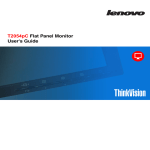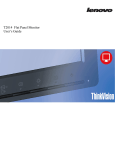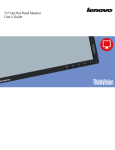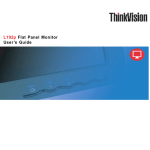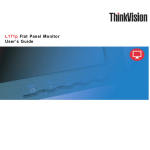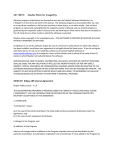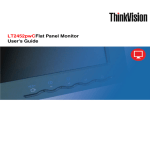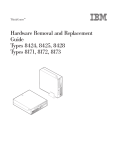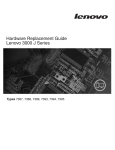Download L151-ENTRY_USER MANUAL.pmd - ps
Transcript
L151 Flat Panel Monitor
User’s Guide
Product numbers
9205-AB2
9165-AB2
First Edition (June 2005)
© Copyright Lenovo 2005.
Portions © Copyright International Business Machines Corporation 2005.
All rights reserved.
U.S. GOVERNMENT USERS - RESTRICTED RIGHTS: Our products and/or services are provided with RESTRICTED
RIGHTS. Use, duplication or disclosure by the Government is subject to the GSA ADP Schedule contract with Lenovo
Group Limited, if any, or the standard terms of this commercial license, or if the agency is unable to accept this Program
under these terms, then we provide this Program under the provisions set forth in Commercial Computer SoftwareRestricted Rights at FAR 52.227-19, when applicable, or under Rights in Data-General, FAR 52.227.14 (Alternate III).
© Copyright Lenovo 2005. © Portions Copyright IBM Corp. 2005.
i
Contents
Safety information iii
Chapter 1. Getting started .......................................................................................... 1-1
Shipping contents ............................................................................................................................................................ 1-1
Attaching the base and handling your monitor ................................................................................................................ 1-1
Product overview ............................................................................................................................................................ 1-2
Types of adjustments .................................................................................................................................................. 1-2
User controls .............................................................................................................................................................. 1-2
Cable lock slot ............................................................................................................................................................ 1-3
Setting up your monitor .................................................................................................................................................. 1-3
Connecting and turning on your monitor ................................................................................................................... 1-3
Registering your option ................................................................................................................................................... 1-5
Chapter 2. Adjusting and using your monitor .......................................................... 2-1
Comfort and accessibility ................................................................................................................................................ 2-1
Arranging your work area .......................................................................................................................................... 2-1
Quick tips for healthy work habits ............................................................................................................................. 2-2
Accessibility information ............................................................................................................................................ 2-3
Adjusting your monitor image ......................................................................................................................................... 2-3
Using the direct access controls ................................................................................................................................. 2-3
Using the On-Screen Display (OSD) controls ............................................................................................................ 2-3
Selecting a supported display mode ................................................................................................................................ .2-5
Understanding power management ................................................................................................................................. 2-6
Caring for your monitor .................................................................................................................................................. 2-7
Detaching the monitor stand ........................................................................................................................................... 2-7
Chapter 3. Reference information ............................................................................. 3-1
Monitor specifications .................................................................................................................................................... .3-1
Troubleshooting .............................................................................................................................................................. 3-2
Manual image setup ................................................................................................................................................... 3-3
Manually installing the monitor driver ....................................................................................................................... 3-4
Service information .................................................................................................................................................... 3-6
Appendix A. Service and Support ............................................................................ A-1
Online technical support ................................................................................................................................................. A-1
Telephone technical support ........................................................................................................................................... A-1
Worldwide telephone list ............................................................................................................................................ A-1
Appendix B. Notices ................................................................................................... B-1
Trademarks .................................................................................................................................................................... B-2
© Copyright Lenovo 2005. © Portions Copyright IBM Corp. 2005.
ii
Safety information
© Copyright Lenovo 2005. © Portions Copyright IBM Corp. 2005.
iii
Chapter 1. Getting started
This User’s Guide contains detailed information on the ThinkVision™ L151 Flat
Panel Monitor. For a quick overview, please see the Setup Poster that was shipped
with your monitor.
Shipping contents
The product package should include the following items:
·
·
·
·
·
·
ThinkVision L151 Flat Panel Monitor Setup Poster
Monitor Safety, Troubleshooting, and Warranty Guide
Reference and Driver CD
ThinkVision L151 Flat Panel Monitor
Power Cord
Analog Interface Cable- Attached to monitor
Attaching the base and handling your monitor
To set up your monitor, please see the illustrations below.
Note: Do not touch the monitor within the screen area. The screen area is glass and
can be damaged by rough handling or excessive pressure.
Note: To attach a VESA mount, please see
“Detaching the monitor stand” on page 2-7.
© Copyright Lenovo 2005. © Portions Copyright IBM Corp. 2005.
1-1
Product overview
This section will provide information on adjusting monitor positions, setting user
controls, and using the cable lock slot.
Types of adjustments
Please see the illustration below for an example of the tilt range.
User controls
Your monitor has controls on the front which are used to adjust the display.
For information on how to use these controls, please see
“Adjusting your monitor image” on page 2-3.
1-2
L151 Flat Panel Monitor User’s Guide
Cable lock slot
Your monitor is equipped with a cable lock slot located on the rear of your monitor
(in the lower right corner). Please see the instructions that came with the cable lock
to learn how to attach it.
Setting up your monitor
This section provides information to help you set up your monitor.
Connecting and turning on your monitor
Note: Be sure to read the Safety Information located in the Monitor Safety,
Troubleshooting, and Warranty Guide before carrying out this procedure.
1. Power off your computer and all attached devices, and unplug the computer power
cord.
Chapter 1. Getting started
1-3
2. Connect the analog signal cable to the video port on the back of the computer.
Note: One end of the signal cable is already pre-attached to your monitor.
3. Insert the power cord into the monitor, then plug the monitor power cord and the
computer cord into grounded electrical outlets.
4. Power on the monitor and the computer.
1-4
L151 Flat Panel Monitor User’s Guide
5. To install the monitor driver, insert the Reference and Driver CD, click Install
driver, and follow the on-screen instructions.
6. To optimize your monitor image, press the Automatic Image Setup key. Automatic
image setup requires that the monitor is warmed up for at least 15 minutes. This
is not required for normal operation.
Note: If automatic image setup does not establish the image that you prefer, perform
manual image setup. See “Manual image setup” on page 3-3.
Registering your option
Thank you for purchasing this Lenovo™ product. Please take a few moments to
register your product and provide us with information that will help Lenovo to better
serve you in the future. Your feedback is valuable to us in developing products and
services that are important to you, as well as in developing better ways to
communicate with you. Register your option on the followingWeb site:
http://www.lenovo.com/register
Lenovo will send you information and updates on your registered product unless you
indicate on the Web site questionnaire that you do not want to receive further
information.
Chapter 1. Getting started
1-5
Chapter 2. Adjusting and using your monitor
This section will give you information on adjusting and using your monitor.
Comfort and accessibility
Good ergonomic practice is important to get the most from your personal computer
and to avoid discomfort. Arrange your workplace and the equipment you use to suit
your individual needs and the kind of work that you perform. In addition, use healthy
work habits to maximize your performance and comfort while using your computer.
For more detailed information on any of these topics, visit the Healthy Computing
Web site at: http://www.ibm.com/pc/ww/healthycomputing
Arranging your work area
Use a work surface of appropriate height and available working area to allow you to
work in comfort.
Organize your work area to match the way you use materials and equipment. Keep
your work area clean and clear for the materials that you typically use and place the
items that you use most frequently, such as the computer mouse or telephone, within
the easiest reach.
Equipment layout and setup play a large role in your working posture. The following
topics describe how to optimize equipment setup to achieve and maintain good
working posture.
Positioning and viewing your monitor
Position and adjust your computer monitor for comfortable viewing by considering
the following items:
· Viewing distance: Optimal viewing distances for monitors range from
approximately 510mm to 760mm (20 in to 30 in) and can vary depending on
ambient light and time of day. You can achieve different viewing distances by
repositioning your monitor or by modifying your posture or chair position. Use a
viewing distance that is most comfortable for you.
· Monitor height: Position the monitor so your head and neck are in a comfortable
and neutral (vertical, or upright) position. If your monitor does not have height
adjustments, you might have to place books or other sturdy objects under the base
of the monitor to achieve the desired height. A general guideline is to position the
monitor such that the top of the screen is at or slightly below your eye-height
when you are comfortably seated. However, be sure to optimize your monitor
height so the line of site between your eyes and the center the monitor suits your
preferences for visual distance and comfortable viewing when your eye muscles
are in a relaxed state.
2-1
© Copyright Lenovo 2005. © Portions Copyright IBM Corp. 2005.
· Tilt: Adjust the tilt of your monitor to optimize the appearance of the screen
content and to accommodate your preferred head and neck posture.
· General location: Position your monitor to avoid glare or reflections on the
screen from overhead lighting or nearby windows.
The following are some other tips for comfortable viewing of your monitor:
· Use adequate lighting for the type of work you are performing.
· Use the monitor brightness, contrast, and image adjustment controls, if equipped,
to optimize the image on your screen to meet your visual preferences.
· Keep your monitor screen clean so you can focus on the screen’s contents.
Any concentrated and sustained visual activity can be tiring for your eyes. Be sure to
periodically look away from your monitor screen and focus on a far object to allow
your eye muscles to relax. If you have questions on eye fatigue or visual discomfort,
consult a vision care specialist for advice.
Quick tips for healthy work habits
The following information is a summary of some important factors to consider to
help you remain comfortable and productive while you use your computer.
· Good posture starts with equipment setup: The layout of your work area and
the setup of your computer equipment have a large effect on your posture while
using your computer. Be sure to optimize the position and orientation of your
equipment by following the tips outlined in “Arranging your work area” on page 2-1
so you can maintain a comfortable and productive posture. Also, be sure to use the
adjustment capabilities of your computer components and office furniture to best
suit your preferences now and as your preferences change over time.
· Minor changes in posture can help avoid discomfort: The longer you sit and
work with your computer, the more important it is to observe your working
posture. Avoid assuming any one posture for an extended period of time.
Periodically make minor modifications in your posture to help deter any
discomforts that might arise. Make use of any adjustments that your office
furniture or equipment provide to accommodate changes in posture
· Short, periodic breaks help ensure healthy computing: Because computing is
primarily a static activity, it is particularly important to take short breaks from
your work. Periodically, stand up from your work area, stretch, walk for a drink of
water, or otherwise take a short break from using your computer. A short break
from work gives your body a welcome change in posture and helps to ensure you
remain comfortable and productive while you do work.
Chapter 2. Adjusting and using your monitor
2-2
Accessibility information
Lenovo is committed to providing greater access to information and technology to
people with disabilities. With assistive technologies, users can access information in
the way most appropriate to their disability. Some of these technologies are already
provided in your operating system; others can be purchased through vendors or
accessed at: http://www.ibm.com/able/
Adjusting your monitor image
This section describes the user control features used to adjust your monitor image.
Using the direct access controls
The direct access controls can be used when the On Screen Display (OSD) is not
displayed.
Note: The direct access controls are blue.
Table 2-1. Direct access controls
Using the On-Screen Display (OSD) controls
The settings adjustable with the user controls are viewed through the On-Screen
Display (OSD), as shown below.
To use the controls:
1. Press
2-3
to open the main OSD menu.
L151 Flat Panel Monitor User’s Guide
2. Use or to move among the icons. Select an icon and press to access that
function. If there is a sub-menu, you can move between options using or ,
then press to select that function. Use or to make adjustments. Press to
save.
3. Press
to move backwards through the sub-menus and exit from the OSD.
4. Press and hold for 10 seconds to lock the OSD. This will prevent accidental
adjustments to the OSD. Press and hold for 10 seconds to unlock the OSD and
allow adjustments to the OSD.
Table 2-2. OSD functions
! "
#
$
#
%
#
#
&#
%
"
"
&
'('
·
·
·
%
)
)
·
· *
·
· * +
&
· ,
&
+
&
·
+
·
+
-
&
&
&
)
.
+/
)
%
0
/
%%
.
+/
%
-
%
Chapter 2. Adjusting and using your monitor
2-4
Table 2-2. OSD functions (continued)
·
·
·
!"
·
·
"
"
#
!
$ !
$
$ !
%
or
·
·
·
&
&
$
'(
'(
'(
Selecting a supported display mode
The display mode the monitor uses is controlled by the computer. Therefore, refer to
your computer documentation for details on how to change display modes.
The image size, position and shape might change when the display mode changes.
This is normal and the image can be readjusted using automatic image setup and the
image controls.
Unlike CRT monitors, which require a high refresh rate to minimize flicker, LCD or
Flat Panel technology is inherently flicker-free.
Note: If your system has previously been used with a CRT monitor and is currently
configured to a display mode outside the range of this monitor, you may need
to re-attach the CRT monitor temporarily until you have re-configured the
system; preferably to 1024 x 768 at 60 Hz, which is the Native Resolution
Display mode.
2-5
L151 Flat Panel Monitor User’s Guide
The display modes shown below have been optimized at the factory.
Table 2-3. Factory set display modes
/01 ( 231
41
/01 ( 051
/1
471 ( 011
41
511 ( /11
8170 ( 4/5
6 //
6 47
/1
6 47
6 43
/1
6 41
6 43
6 43
Understanding power management
Power management is invoked when the computer recognizes that you have not used
your mouse or keyboard for a user-definable period. There are several states as
described in the table below.
For optimal performance, switch off your monitor at the end of each working day, or
whenever you expect to leave it unused for long periods during the day.
Table 2-4. Power indicator
!
$!*
!
)
$
%
+
+ !
,
')'"-. ,#"
!$
!$
$!
%
+
+ !
,
')'"-. ,#"
!$
!$
Chapter 2. Adjusting and using your monitor
2-6
Caring for your monitor
Be sure to turn off the power before you perform any maintenance on the monitor.
Do not:
· Apply water or liquid directly to your monitor.
· Use solvents or abrasives.
· Use flammable cleaning materials to clean your monitor or any other electrical
equipment.
· Touch the screen area of your monitor with sharp or abrasive items. This type of
contact may cause permanent damage to your screen.
· Use any cleaner which contains an anti-static solution or similar additives. This
may harm the coating of the screen area.
Do:
· Lightly dampen a soft cloth with water and use this to gently wipe the covers and
the screen.
· Remove grease or finger marks with a damp cloth and a little mild detergent.
Detaching the monitor stand
Gently squeeze both ends of the cylinder and remove in the direction shown.
This allows access to the screws that attach the stand to the monitor.
2-7
L151 Flat Panel Monitor User’s Guide
Chapter 3. Reference information
This section contains monitor specifications, instructions to manually install the
monitor driver, troubleshooting information, and service information.
Monitor specifications
Table 3-1. Monitor specifications for type-model 9205-AB2
!
>;' 74
;45 8
>4 59
?
>;' '
?
=
''8 @
/
(5 A'6
6
$2
>' @5
?
'9;
>;7 6
?
# 3
::9
>9 @9
?
# 3
'65
>;; @8
"
3
6 :@8
%
?
> 6;6
? >$?
) 46 76 A ' !"
;66 ( :56 $
# 3
?
6
;66
$
;7
%
B '6 =
.
B:=
%
B;=
-
%
'55 '
$
) 87
! "
%
$
%
C
%
;6:5 3
849
>
>
68$
3?
3?
96 #!"
$2
%#
! "
>$2
?
/
C
$
.
-
© Copyright Lenovo 2005. © Portions Copyright IBM Corp. 2005.
C
*
%
%
'6 !" ( 4' !"
74 !" ( 88 !"
;6:5 3 849
'76
;66
46 !"
>766
@76 1?
(:66
466
>(56
;566 1?
(:6
46
>(5
;566 1?
6
6
6
3-1
Table 3-1. Monitor specifications for type-model 9205-AB2 (continued)
!
%
-
;6D
96D
7D
@7D
7D
@7D
Troubleshooting
If you have a problem setting up or using your monitor, you might be able to solve it
yourself. Before calling your dealer or Lenovo, try the suggested actions that are
appropriate to your problem.
Table 3-2. Troubleshooting
/
&-
/
*
%
%
·
%
&
&
)
%
%
)
%
&
:(7
%
·
=
%
%
)
)
%
%
)
·
/
C
/
%
%
&
%
%
%
%
&
;('
/
%
&
%
-
&
:('
/
&
%
&&
:('
/
· /
·
· /
·
·
· /%
· /%
· /
3-2
L151 Flat Panel Monitor User’s Guide
&
%
%
&
;('
Table 3-2. Troubleshooting (continued)
/
%
·
%
%
&E
%
&
:(4
-
·
%
%
/
/
&
%
%
%
)
&
;('
%
&
/
%
&
3
/
-
0
3
)
%
3 )&
)&
#
0
· 1 ""%
3
%
· ! "
"
<
·
(;
&
·
:('
%
%
&
%
:('
+ ;6:5
%
%
3 849
46 !"
&#
&
&
"
%
&
:(7
)
=
)%
%
%
%
>
?
%
%
%
%
Manual image setup
If automatic image setup does not establish the image that you prefer, perform
manual image setup.
Note: Have your monitor powered on for about 15 minutes, until the monitor warms
up.
at the bottom of the monitor to open the OSD menu.
1. Press
and press to access.
2. Use or to select
3. Use or to select Clock and Phase adjustment.
Chapter 3. Reference information
3-3
· Clock (pixel frequency) adjusts the number of pixels scanned by one horizontal
sweep. If the frequency is not correct, the screen shows vertical stripes and the
picture does not have the correct width.
· Phase adjusts the phase of the pixel clock signal. With a wrong phase adjustment,
the picture has horizontal disturbances in light picture.
4. When the image no longer looks distorted, save the Clock and Phase adjustments.
to leave the OSD menu.
5. Press
Manually installing the monitor driver
Below are steps for manually installing the monitor driver in Microsoft® Windows
XP® and Microsoft Windows 2000 Professional. Please see the Install Driver section
of the Reference and Driver CD for automatic installation.
Installing the monitor driver in Windows XP
To use the Plug and Play feature in Windows XP, files should be loaded from the
Reference and Driver CD.
Note: This section must be completed before continuing with the Windows XP
automatic image setup.
1.
Turn off the computer and all attached devices.
2.
Ensure that the monitor is connected correctly.
3.
Turn on the monitor and then the system unit. Allow the system to boot into
Windows XP.
4.
Open the Display Properties window by clicking Start Settings Control
Panel, and then double-clicking the Display icon.
5.
Click the Settings tab.
6.
Click the Advanced button.
7.
Click the Monitor tab.
8.
Click the Properties button.
9.
Click the Drivers tab.
10. Open the Hardware Update Wizard window by clicking on Update Driver,
and then click Next.
11. Select Install from a list or Specific location(Advanced), and then click
Next. 12. Insert the Setup CD into the CD drive, then click the Have Disk
button.
13. Click OK.
14. Ensure that the CD drive letter is selected.
15. Choose ThinkVision L151 Monitor and click OK. The files will be copied
from the CD to your hard disk drive.
3-4
L151 Flat Panel Monitor User’s Guide
16.
17.
Close all open windows and remove the CD.
Restart the system. The system will automatically select the maximum refresh
rate and corresponding Color Matching Profiles.
Note: On LCD monitors, unlike CRTs, a faster refresh rate does not improve display
quality. Lenovo recommends using either 1024 x 768 at a refresh rate of 60 Hz,
or 640 x 480 at a refresh rate of 60 Hz.
Installing the monitor driver in Windows 2000
To use the Plug and Play feature in Windows 2000, files should be loaded from the
Reference and Driver CD.
Note: This section must be completed before continuing with the Windows 2000
automatic image setup.
1.
Turn off the computer and all attached devices.
2.
Ensure that the monitor is connected correctly.
3.
Turn on the monitor and then the system unit. Allow the system to boot into
Windows 2000.
4.
Open the Display Properties window by clicking Start Settings Control
Panel, and then double-clicking the Display icon.
5.
Click the Settings tab.
6.
Click the Advanced button.
7.
Click the Monitor tab.
8.
Click the Properties button.
9.
Click the Drivers tab.
10. Open the Upgrade Device Driver Wizard window by clicking on Update
Driver, and then click Next.
11. Select Display a list of the known drivers for this device so that I can
choose a specific driver, and then click Next.
12. Insert the Setup CD into the CD drive, then click the Have Disk button.
13. Click OK.
14. Ensure that the CD drive letter is selected.
15. Choose ThinkVision L151 Monitor and click OK. The files will be copied
from the CD to your hard disk drive.
16. Close all open windows and remove the CD.
17. Restart the system. The system will automatically select the maximum refresh
rate and corresponding Color Matching Profiles.
Note: On LCD monitors, unlike CRTs, a faster refresh rate does not improve display
quality. Lenovo recommends using either 1024 x 768 at a refresh rate of 60 Hz,
or 640 x 480 at a refresh rate of 60 Hz.
Chapter 3. Reference information
3-5
Getting further help
If you still can’t solve your problem, please contact the Lenovo Support Center. For
more information on contacting the Customer Support Center, please see Appendix
A, “Service and Support,” on page A-1.
Service information
Product numbers
The product number for your monitor is located on the side of the display bezel as
shown below.
Customer responsibilities
The warranty does not apply to a product which has been damaged due to accident,
misuse, abuse, improper installation, usage not in accordance with product
specifications and instructions, natural or personal disaster, or unauthorized
alterations, repairs or modifications.
The following are examples of misuse or abuse and not covered by warranty:
· Images burned onto the screen of a CRT monitor. Burned image is preventable by
utilizing a moving screen saver or power management.
· Physical damage to covers, bezel, base and cables.
· Scratches or punctures on monitor screens.
3-6
L151 Flat Panel Monitor User’s Guide
Service parts
The following parts are for use by Lenovo service, or Lenovo authorized dealers, to
support the customer warranty. Parts are for service use only. The table below shows
information for model 9205-AB2
Table 3-3. List of service parts
! " #!
"
$
%
# % $
56<8:@'
#
56<8:@4
$
( 0;7;
@:67(
:
@:67(
:
56<8:@8
@:67(
:
56<8:@9
@:67(
:
>
?
Chapter 3. Reference information
3-7
Appendix A. Service and Support
The following information describes the technical support that is available for your
product, during the warranty period or throughout the life of the product. Refer to
your Lenovo Statement of Limited Warranty for a full explanation of Lenovo
warranty terms.
Online technical support
Online technical support is available during the life of your product through the
Personal Computing Support Web site at http://www.lenovo.com/think/support.
During the warranty period, assistance for replacement or exchange of defective
components is available. In addition, if your option is installed in a ThinkPad or
ThinkCentre computer, you might be entitled to service at your location. Your
technical support representative can help you determine the best alternative.
Telephone technical support
Installation and configuration support through the Customer Support Center will be
withdrawn or made available for a fee, at Lenovo’s discretion, 90 days after the
option has been withdrawn from marketing. Additional support offerings, including
step-by-step installation assistance, are available for a nominal fee.
To assist the technical support representative, have available as much of the
following information as possible:
· Option name
· Option number
· Proof of purchase
· Computer manufacturer, model, serial number, and manual
· Exact wording of the error message (if any)
· Description of the problem
· Hardware and software configuration information for your system
If possible, be at your computer. Your technical support representative might want to
walk you through the problem during the call.
Worldwide telephone list
Phone numbers are subject to change without notice. For the most current phone
numbers, go to http://www.lenovo.com/think/support and click Support phone list.
A-1
© Copyright Lenovo 2005. © Portions Copyright IBM Corp. 2005.
!"# "
%
$
&
'%
" % .
(&
*
+
- .
%
,
&&
(&
(&
*
%
%
,
&&
&&
+
" ,
)
" 2
$
3
" 2
)
)
&&
)
)
&&
/
0
/
10
&
%
) )
%
$
$
%
'%
! 3
10
+
&
#
4 %5 %
6 676
4 . $
..
3 8$
.9
))
$
* 8$
1' % 1$
)
7
%
&
)
&
+&
2
7& 9
/ . 8
/ .
(&
*
/
%
,
+
&&
&&
7& 9
:6
3
0
;
/ .
7& 9
) )
&
Appendix A. Service and Support
A-2
%
2
;(966(5:4@;; >
2
:76(74@4 >
2
A'94(4;(;8@4(4@@
1
E
=
>1
%
?
E
=
=
>1
%
%
?
E
=
>,
%
?
1
,
%
?
?
+ 6@(57@(4@46
+ A'79(966(;(5:46
+ 6:'9(778(576
>
?+ 69;6(4';(:;'
>
?+ 69;6(4';(6:6
+ 686':(;7(5@:6;
+ 6;967(:7('7(79
,
A'6(:;6(496(;866
,
''7(95@6 >
!
/
?
G
+ :':(5:::
+ 77:(::'5
>
!
%
?
A'4(;('9:(78:6
;466(55(4444
/ 1
>2
?
+ A@;(96(:489(9@56
966(;56('777
A4:(:;(:7;(:@77
>2
)
)
E
=
>2
%
E
=
>
H
A-3
%
?
%
?
+ 6;(9;7(@:6:
+ 6;(99;(;555
+ 6:(86';(4;6;
+ A'@(966(9:66@5
?
/
1
+
+ 6;:6(998(986
+ A9;(54(:44(58:5
/
/
1
+
+ 6;:6(998(985
+ A9;(54(:44(58:5
L151 Flat Panel Monitor User’s Guide
%
H
H
2
)
1
H
ϣ2
2
)
)ϣ
%
+
6;:6(779(4@7
+ A9;(55(:66(9444
>H
?
F
;799(796; >F
0
A'94(4;(;8@4(4@@
0
A'94(4;(;8@4(4@@
03
A'7:(:@9(@88(764' >1
#
%
?
;966(99(9779 >2
)
#
A'74(:'(5;87
# 3
66;(944(5'5(:696 >
#
2
.
.
)#
I
A55 >6?;587(777(677
6966(554(;5@ >2
:77(4479 >
%
%?
?
A';(:6(7;5(7886 >
.
.
?
E
=
>.
?
?
?
+ 449;(;;66
+ 9;7:(;776
%
?
:64(4658 >
?
6(966(76(944 >
?
;966(;999(;5:4
A4'(:(@@7(95:6
>2
)
?
A59(::(989(4@@@
A'7;(:;(9@:(8;58 >
*
*
?
A5(6:;(::5(56;7
1
A8(6@7(@56(:666 >*
;966(';8:(999 >2
?
)
)#
%?
A5:;(:(5@75(;:;8
Appendix A. Service and Support
A-4
%
A'94(;(58@4(4@@
@;(8;5(8@9'
@;('@8(476'
>
?
0
A@5(;;(:559(55: >2
"
E
=
>
%
?
E
=
>,
%
)1
+ 69(588(55:6
+ 688(;;8(;656
+ 679('''(6@66
+ 6966(77(75(75
?
)
/
994(:(98:'(@8@@ >#
/
;(966(:@@(::@ >/
/
%
E
F
A-5
?
E
=
=
>2
+ 6;587(777(677
>
?+ 69867(766(@66
>
?+ 69578(;7;(7;4
%
%
?
;(966(5:4(8'89
>2
?
E
$
?
66966(554'(:65;
>/
?
E
$
?
%
"
666(5;;(667(445@ >
?
6(966(;66(:6;; >
1
1
>2
?
!
!
)$
L151 Flat Panel Monitor User’s Guide
?
+ 95(5(95'4487
#
%+ 95(9(9:@(7;46
Appendix B. Notices
Lenovo may not offer the products, services, or features discussed in this document in
all countries. Consult your local Lenovo representative for information on the
products and services currently available in your area. Any reference to a Lenovo
product, program, or service is not intended to state or imply that only that Lenovo
product, program, or service may be used. Any functionally equivalent product,
program, or service that does not infringe any Lenovo intellectual property right may
be used instead. However, it is the user’s responsibility to evaluate and verify the
operation of any other product, program, or service.
Lenovo may have patents or pending patent applications covering subject matter
described in this document. The furnishing of this document does not give you any
license to these patents. You can send license inquiries, in writing, to:
Lenovo (United States), Inc.
500 Park Offices Drive, Hwy. 54
Research Triangle Park, NC 27709
U.S.A.
Attention: Lenovo Director of Licensing
LENOVO GROUP LTD. PROVIDES THIS PUBLICATION “AS IS” WITHOUT
WARRANTY OF ANY KIND, EITHER EXPRESS OR IMPLIED, INCLUDING,
BUT NOT LIMITED TO, THE IMPLIED WARRANTIES OF NONINFRINGEMENT, MERCHANTABILITY OR FITNESS FOR A PARTICULAR
PURPOSE. Some jurisdictions do not allow disclaimer of express or implied
warranties in certain transactions, therefore, this statement may not apply to you.
This information could include technical inaccuracies or typographical errors.
Changes are periodically made to the information herein; these changes will be
incorporated in new editions of the publication. Lenovo may make improvements
and/or changes in the product(s) and/or the program(s) described in this publication
at any time without notice.
The products described in this document are not intended for use in implantation or
other life support applications where malfunction may result in injury or death to
persons. The information contained in this document does not affect or change
Lenovo product specifications or warranties. Nothing in this document shall operate
as an express or implied license or indemnity under the intellectual property rights of
Lenovo or third parties. All information contained in this document was obtained in
specific environments and is presented as an illustration. The result obtained in other
operating environments may vary.
Lenovo may use or distribute any of the information you supply in any way it believes
appropriate without incurring any obligation to you.
© Copyright Lenovo 2005. © Portions Copyright IBM Corp. 2005.
B-1
Any references in this publication to non-Lenovo Web sites are provided for
convenience only and do not in any manner serve as an endorsement of those Web
sites. The materials at those Web sites are not part of the materials for this Lenovo
product, and use of those Web sites is at your own risk.
Any performance data contained herein was determined in a controlled environment.
Therefore, the result obtained in other operating environments may vary
significantly. Some measurements may have been made on development-level
systems and there is no guarantee that these measurements will be the same on
generally available systems. Furthermore, some measurements may have been
estimated through extrapolation. Actual results may vary. Users of this document
should verify the applicable data for their specific environment.
Trademarks
The following terms are trademarks of Lenovo in the United States, other countries,
or both:
Lenovo
ThinkCentre
ThinkPad
ThinkVision
Microsoft, Windows, and Windows NT are trademarks of Microsoft Corporation in
the United States, other countries, or both.
Other company, product, or service names may be trademarks or service marks of
others.
B-2
L151 Flat Panel Monitor User’s Guide

































